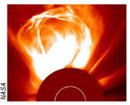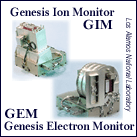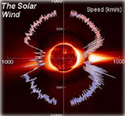|





|
 |
 |
  |
|
 |
This advanced high school or post-secondary
science and mathematics module is about studying real solar
wind information collected from the Genesis spacecraft
and posted on the Los Alamos National Laboratory (LANL)
Genesis Science Data Web site. If you're using Genesis
science modules for the first time, read the User's
Guide thoroughly before you begin. (View User's Guide
as a PDF.)
The Portable Document Format (PDF) is used to distribute
fully formatted, print-quality documents electronically.
The following information is available to view and print
as a PDF file with Adobe's Acrobat reader. To install
the FREE Adobe Acrobat Reader, visit the Adobe
Web site.
Take a look at other science
modules available. All technical terms in the science
modules are compiled in the Glossary for
easy access.
|
|
  |
 |

This module focuses on the solar
wind information obtained by the Genesis spacecraft.
The Genesis spacecraft collects pristine solar wind material
(ionic particles from the Sun) that will provide clues
about the elemental composition of the original solar
nebula. For more information about the Genesis mission,
please visit the Genesis
Mission page.
The primary mission of Genesis is solar
wind sample return. However, the spacecraft contains
electron and ion monitors that send back information
about the solar wind in near real time. Data Analysis
and Generalizations is an advanced high school module
or post-secondary module that engages students in studying
real solar wind information collected from the Genesis
spacecraft and posted on the Los
Alamos National Laboratory (LANL) Genesis Science Data
Web site.
Data Analysis and Generalizations emphasizes
experimental design and inquiry science concepts. The National
Science Education Standards "Science as Inquiry" standard
calls for students to learn how to analyze evidence
and data. "The evidence they analyze may be from their
investigations, other students' investigations, or
databases. Data manipulation and analysis strategies
need to be modeled by teachers of science and practiced
by students. Determining the range of the data, the
mean and mode values of the data, plotting the data,
developing mathematical functions from the data, and
looking for anomalous data are all examples of analyses
students can perform." (NRC,
1996*).
The Principles
and Standards for School Mathematics data analysis
and probability standards state that high school students
should learn sophisticated ways to collect and analyze
data and draw conclusions from data in order to answer
questions or make informed decisions. The standards
in the "Curriculum Connections" below will assist you
in identifying the major concepts addressed in this
module.
In Data Analysis and Generalizations,
students ask questions that can be answered by analyzing
this archived information. Though designed to be
an open-inquiry investigation, teachers are provided
some suggestions for guiding students who want or
need assistance in designing and conducting the investigation.
Students draw conclusions and make generalizations
that are then reviewed by their peers. Finally, students
communicate their investigations to an audience of
their peers who will assist the instructor in assessing
the process. This module is organized using a learning
cycle and designed to be taught in a sequence. However,
you are welcome to select among the activities that
most closely align with your curriculum needs.
|
|
|
|
|
|
Adobe's
Acrobat Reader©

The
Portable Document Format (PDF) is used to distribute
fully formatted, print-quality documents. |
|
|
|
| |
|
|
|
|
|
|
|
|
|
|
|
|
|
|
|
|
|
|
|
|
|
|
|
|
|
|
|
|
|
|
|
 |
|
| |
|
 |
Students are briefed on the
Genesis mission and the three basic types of solar wind that
are being detected by the Genesis Ion Monitor (GIM)  and
Genesis Electron Monitor (GEM). Students will develop an understanding
of the Sun’s solar wind, the Earth’s magnetosphere,
and how the Genesis spacecraft collected solar wind at L1. and
Genesis Electron Monitor (GEM). Students will develop an understanding
of the Sun’s solar wind, the Earth’s magnetosphere,
and how the Genesis spacecraft collected solar wind at L1.
|
|
 |
|
|
|
|
|
|
|
|
|
|
|
| In the activities of this module,
the teacher's primary role is Socratic. Through effective questioning,
students should become aware of the patterns found in the solar
wind data.
In this activity, students will take a "first look" at
actual solar wind data that has been collected and sent to
Earth by the Genesis spacecraft. The data summary sheets contain
seven panels: Speed, Temperature, Expected Temperature/Measured
Temperature, Density, Helium ratio, Coronal Mass Ejection (CME),
and Bi-Directional Electron Indicator (BDE).
|
|
|
|
|
 |
|
|
|
|
 |
After the teacher models the development
of an investigation from the solar wind information, students
develop an investigation idea based on one of the questions they
had in the Exploration section. Students will then organize and
communicate the data in a meaningful way. Students will analyze
the information in order to answer their questions and make models,
generalizations or explanations.
 During
this section, students are encouraged to use technology and
mathematics to make sense of the information that is being
analyzed in light of their question(s). Students will use statistical
analysis and graphing technology to understand and organize
the data and to communicate their explanations to peers. If
several models, explanations, or generalizations occur due
to this analysis, students will need to make decisions about
which explanation best fits the evidence found in the data. During
this section, students are encouraged to use technology and
mathematics to make sense of the information that is being
analyzed in light of their question(s). Students will use statistical
analysis and graphing technology to understand and organize
the data and to communicate their explanations to peers. If
several models, explanations, or generalizations occur due
to this analysis, students will need to make decisions about
which explanation best fits the evidence found in the data.
|
|
|
|
|
 |
|
| | |
 |
Students refine their investigations
by having their methodology, procedures, and data analysis reviewed
in a peer review process. Through this process, students will
have the opportunity to see the work of others in light of what
they have already done. This gives students a chance to evaluate
draft reports from peers using a rubric. One part of the peer
review process gives the students a chance to discuss the evaluations
with the reviewers. In this way, suggestions and arguments can
be made clear for each study. Students then have the opportunity
to make revisions or alter their explanations and generalizations
based on peer feedback.
 Using
a rubric, students prepare to present their findings to the
class as a poster session at a "State of the Solar System
Conference." Each student will develop a one-page abstract
that summarizes the process and findings. The poster will illustrate
the question, methodology, and data (including anomalies) in
the form of charts, illustrations, and graphs in order to show
relationships. During the poster session, the students will
communicate the process used, report any revisions made as
a result of the peer review, and the generalizations resulting
from their findings. During the poster session, the class will
make recommendations and collaborate with the instructor to
assess the student work using the same rubric that was used
during preparation. Using
a rubric, students prepare to present their findings to the
class as a poster session at a "State of the Solar System
Conference." Each student will develop a one-page abstract
that summarizes the process and findings. The poster will illustrate
the question, methodology, and data (including anomalies) in
the form of charts, illustrations, and graphs in order to show
relationships. During the poster session, the students will
communicate the process used, report any revisions made as
a result of the peer review, and the generalizations resulting
from their findings. During the poster session, the class will
make recommendations and collaborate with the instructor to
assess the student work using the same rubric that was used
during preparation.
|
|
|
|
|
 |
|
|
| |
 |
| Analysis of the additional data
being collected by the Genesis Electron Monitor, processed on
board the Genesis spacecraft, and found on the Los
Alamos National Laboratory (LANL) Genesis data Web site, provides an authentic
assessment activity that incorporates all of these requirements
into this Data Analysis Module.
This activity concludes with six questions
that should help you assess your students' ability to interpret
the presented data, to deal with data that can be interpreted
in more than one way, and to develop new questions that could
be the basis of further scientific investigation.
|
|
|
|
|
|
|
|
|
|
|
| *National
Research Council. 1996. Washington DC: National Academy Press. |
|
|
|
|
 |
|
|
|
|
 |
|
|
|
|
|
|
| |
|
 |
|
| |
|
|
| Writers: |
~Dr.
Donna Bogner, McREL
~John Ristvey, McREL
|
| Technical Editors: |
~Roger Carlson, JPL
~Jacinta Behne, McREL
|
| Graphics and Layout: |
~Susanne Chastain, McREL
|
|
| Special thanks to the following reviewers: |
~Dr. Roger Wiens, Los Alamos National
Laboratory
~David Seidel, Jet Propulsion Laboratory
~Art Hammon, Jet Propulsion Laboratory
~Aimee Whalen, Jet Propulsion Laboratory
~Shirley Wolf, Jet Propulsion Laboratory
~Mike Arnold, McREL
~Jacinta Behne, McREL
|
|
|
|
|
|
|
|
|
|
|
|
|
|
|
|
|
|
